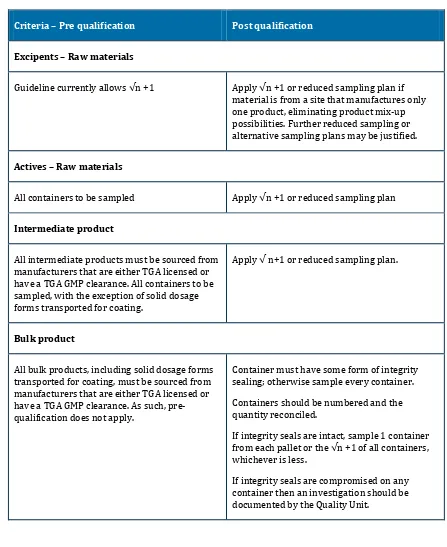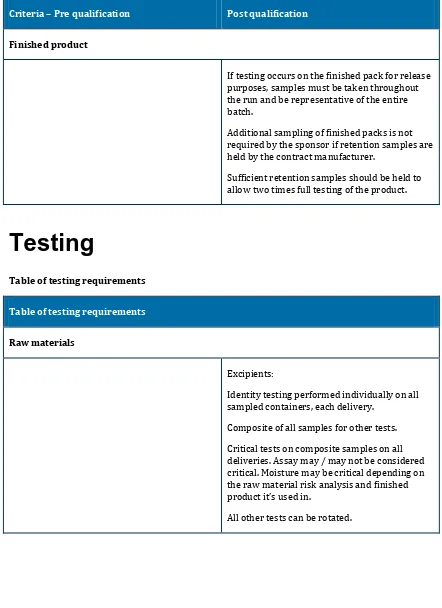Technical guidance on the
interpretation of manufacturing
standards
Sampling and testing of complementary
medicines
Technical working group on complementary
medicines
About the Therapeutic Goods Administration (TGA)
• The Therapeutic Goods Administration (TGA) is part of the Australian Government Department of Health, and is responsible for regulating medicines and medical devices.
• The TGA administers the Therapeutic Goods Act 1989 (the Act), applying a risk management approach designed to ensure therapeutic goods supplied in Australia meet acceptable standards of quality, safety and efficacy (performance), when necessary.
• The work of the TGA is based on applying scientific and clinical expertise to decision-making, to ensure that the benefits to consumers outweigh any risks associated with the use of medicines and medical devices.
• The TGA relies on the public, healthcare professionals and industry to report problems with medicines or medical devices. TGA investigates reports received by it to
determine any necessary regulatory action.
• To report a problem with a medicine or medical device, please see the information on the TGA website <http://www.tga.gov.au>.
Copyright
© Commonwealth of Australia 2013
This work is copyright. You may reproduce the whole or part of this work in unaltered form for your own personal use or, if you are part of an organisation, for internal use within your organisation, but only if you or your
organisation do not use the reproduction for any commercial purpose and retain this copyright notice and all disclaimer notices as part of that reproduction. Apart from rights to use as permitted by the Copyright Act 1968 or allowed by this copyright notice, all other rights are reserved and you are not allowed to reproduce the whole or any part of this work in any way (electronic or otherwise) without first being given specific written permission from the Commonwealth to do so. Requests and inquiries concerning reproduction and rights are to be sent to the TGA Copyright Officer, Therapeutic Goods Administration, PO Box 100, Woden ACT 2606 or emailed to
Version history
Version Description of change Author Effective date
V1.0 Original publication Office of Manufacturing Quality
12/05/2009
V1.1 Template update Office of Manufacturing Quality
Contents
Technical working groups
5
About this guidance
5
Disclaimer ______________________________________________________________________ 5
Further information __________________________________________________________ 5
Purpose __________________________________________________________________________ 6
Scope _____________________________________________________________________________ 6
Glossary _________________________________________________________________________ 6
Intermediate product ______________________________________________________________________ 6
Bulk product ________________________________________________________________________________ 6
Finished product ___________________________________________________________________________ 6
Certificate of Analysis (C of A) ____________________________________________________________ 7
Sampling
7
Testing
8
Further items for clarification
10
Extension of assigned expiry date for raw materials__________________ 10
Extension of assigned expiry date for bulk and finished goods _____ 10
Premixes ______________________________________________________________________ 11
Preservatives in raw materials ___________________________________________ 11
Herbs and herbal extracts _________________________________________________ 11
Multi herb materials _____________________________________________________________________ 11
Rotational testing ____________________________________________________________ 11
Starting material grade _____________________________________________________ 11
Technical working groups
Technical Working Groups have been established by the TGA’s OMQ to bring together manufacturing technical expertise from industry and the regulator to address the standards for the application of Manufacturing Standards.
The aim of the Technical Working Groups is to:
• Establish a formal and transparent forum for industry and the regulator to work cohesively in order to provide advice on the application of manufacturing standards. • Improve and foster industry implementation of manufacturing standards, and enhance
regulatory audit consistency in the application of manufacturing standards.
• Identify and discuss key areas of concern, and address emerging issues relevant to the interpretation and application of manufacturing standards.
• Develop specific guidance documents as appropriate.
Guidance documents are not intended to establish a minimum standard of practice for audit purposes. Guidance documents are not enforceable.
About this guidance
This Guidance is not mandatory or enforceable under law. It is not intended to be restrictive. It describes a way that a manufacturer may use to demonstrate compliance with the relevant Code of GMP or QMS Standard.
Disclaimer
This document is provided for guidance only and has been developed on the basis of current knowledge of the subject matter. It should not be relied upon to address every aspect of the relevant legislation. Please also refer to the Therapeutic Goods Act, and the Therapeutic Goods Regulations, 1990 for legislative requirements and the relevant Code of GMP or Quality Management System Standard for technical requirements.
Further information
The Office of Manufacturing Quality of the Therapeutic Goods Administration (TGA) can be contacted by:
Email:
• General & Australian manufacturing enquiries: [email protected] • Overseas manufacturing enquiries: [email protected]
Phone:
• 02 6232 8156
• Users who are deaf or have a hearing or speech impairment can call through the National Relay Service:
– TTY or computer with modem users phone 1800 555 677 then ask for 1800 020 653
– Speak and listen (speech to speech relay) users phone 1800 555 727 then ask for 1800 020 653
Fax:
• 02 6232 8426
Post:
• Office of Manufacturing Quality, TGA, PO Box 100, Woden ACT 2606, Australia
Website:
• <http://www.tga.gov.au/industry/manuf.htm>
Purpose
This guidance is intended to clarify the interpretation of the Australian Code of GMP for Medicinal Products in relation to the sampling and testing of complementary medicines. It covers the sampling and testing requirements for raw materials used in the manufacture of complementary medicines and complementary medicines, whether in the form of intermediate, bulk or finished products.
It also describes a plan for reduced sampling and testing once an approved supplier has been qualified.
Scope
This guidance is relevant to complementary medicines.
Glossary
Intermediate product
Partly processed material which must undergo further manufacturing steps before it becomes a bulk product.
Bulk product
Any product that has completed all processing steps up to, but not including, final packaging.
Finished product
Certificate of Analysis (C of A)
A certificate issued by the manufacturer of the product reporting the test results obtained for the specified lot(s) of product supplied.
Sampling
Table of sampling criteria and qualifications
Criteria – Pre qualification Post qualification
Excipents – Raw materials
Guideline currently allows √n +1 Apply √n +1 or reduced sampling plan if
material is from a site that manufactures only one product, eliminating product mix-up possibilities. Further reduced sampling or alternative sampling plans may be justified.
Actives – Raw materials
All containers to be sampled Apply √n +1 or reduced sampling plan
Intermediate product
All intermediate products must be sourced from manufacturers that are either TGA licensed or have a TGA GMP clearance. All containers to be sampled, with the exception of solid dosage forms transported for coating.
Apply √ n+1 or reduced sampling plan.
Bulk product
All bulk products, including solid dosage forms transported for coating, must be sourced from manufacturers that are either TGA licensed or have a TGA GMP clearance. As such, pre-qualification does not apply.
Container must have some form of integrity sealing; otherwise sample every container.
Containers should be numbered and the quantity reconciled.
If integrity seals are intact, sample 1 container
from each pallet or the √n +1 of all containers,
whichever is less.
Criteria – Pre qualification Post qualification
Finished product
If testing occurs on the finished pack for release purposes, samples must be taken throughout the run and be representative of the entire batch.
Additional sampling of finished packs is not required by the sponsor if retention samples are held by the contract manufacturer.
Sufficient retention samples should be held to allow two times full testing of the product.
Testing
Table of testing requirements
Table of testing requirements
Raw materials
Excipients:
Identity testing performed individually on all sampled containers, each delivery.
Composite of all samples for other tests.
Critical tests on composite samples on all deliveries. Assay may / may not be considered critical. Moisture may be critical depending on the raw material risk analysis and finished product it’s used in.
Table of testing requirements
Actives:
Identity testing performed individually on all sampled containers, each delivery.
Composite all samples for other tests.
Critical tests on composite samples on all deliveries. Assay considered critical if part of release specification.
Minerals should not be excluded from critical assay. Moisture and related substances may be critical depending on the raw material.
All other tests may be rotated.
Intermediate product
Sufficient testing should be conducted to ensure quality of the product.
Bulk product
Single Active products
Sufficient testing, including active ingredient assay where possible and Uniformity of Content testing (if required), should be conducted to the quality of the product.
Customers can accept C of A from TGA licensed or GMP clearance issued manufacturers without further testing if the following issues are addressed:
Verification of supply chain (may be included in supplier qualification).
Examination of packaging for integrity of seal.
Individual samples visually inspected.
Table of testing requirements
Multi Active products
Sufficient testing should be conducted to ensure the quality of the product. Reduced and/or rotational testing may be used where justified.
Customers can accept C of A from TGA licensed or GMP clearance issued manufacturers without further testing if the following issues are addressed:
Verification of supply chain (may be included in supplier qualification).
Examination of packaging for integrity of seal.
Individual samples visually inspected.
Visual comparison of bulk materials for identification purposes.
Finished product
If testing occurring at this stage, same protocol to be followed as for bulk product.
No need for repeat chemical testing if already performed on bulk product.
Micro testing on finished pack for liquids and semi solids if applicable.
Further items for clarification
Extension of assigned expiry date for raw materials
Extensions of assigned expiry date are permitted up to the manufacturer’s recommended expiry date. Extensions beyond the manufacturer’s recommended expiry date require data (e.g. assay and impurity testing) clearly justifying the extension.
Extension of assigned expiry date for bulk and finished
goods
Extensions of assigned expiry date are permitted provided data (e.g. stability data) is available supporting the extension. Extension beyond 5 years from original date of
Premixes
Multi active ingredients eg vitamin premixes: Test all ingredients where possible.
Preservatives in raw materials
Testing of preservatives not required
Herbs and herbal extracts
Identification testing is critical. Active component testing is critical if component reported on label. Microbiological testing as required. Heavy metals tested on a rotational basis. C of A result acceptable for other criteria, including pesticides and residual solvents (where relevant).
If herbal extracts are sourced from a manufacturer that is either TGA licensed or has a TGA GMP clearance then extracts can be accepted on a C of A without further testing if the following issues are addressed:
• Verification of supply chain (may be included in supplier qualification). • Examination of packaging for integrity of seal.
Multi herb materials
Must be able to uniquely identify each herb in the material. If multi herb materials are sourced from a manufacturer that is either TGA licensed or has a GMP clearance then multi herb materials can be accepted on a C of A without further testing.
Rotational testing
May be implemented once supplier qualified. Any rejected material relating to quality issue from supplier, should result in reverting status back to non-qualified.
Rotational testing is considered to follow the process below: • Perform critical tests on each delivery plus one non critical test
• Non critical test are rotated. It is expected that all test are to be done and none are skipped without adequate justification.
Starting material grade
References
• PIC/S Guide to Good Manufacturing Practice for Medicinal Products – 15 January 2009, including Annexes
Therapeutic Goods Administration
PO Box 100 Woden ACT 2606 AustraliaEmail: [email protected] Phone: 1800 020 653 Fax: 02 6232 8605



